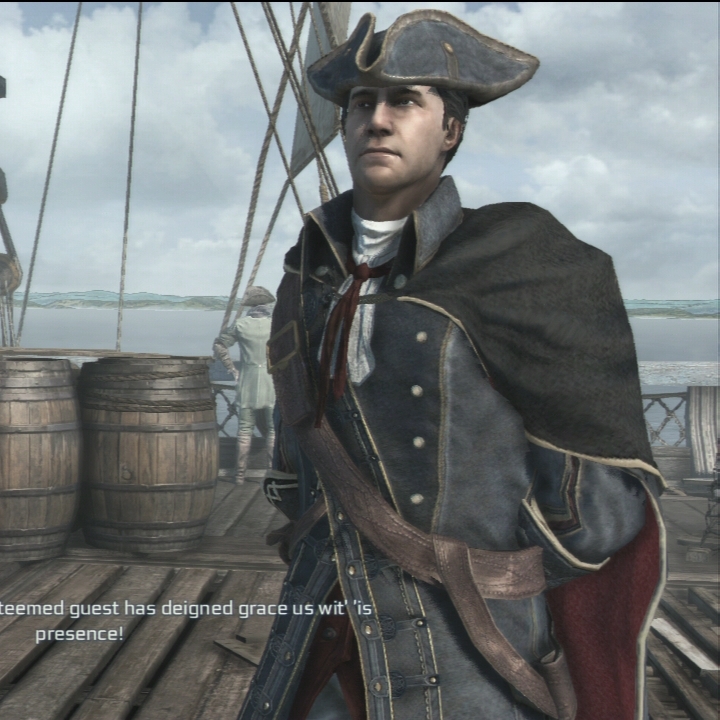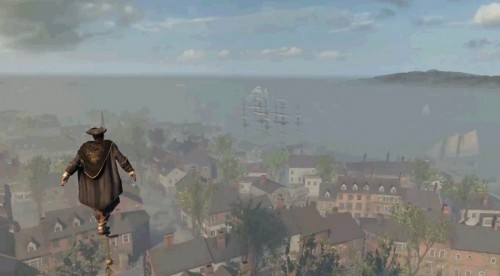I have waited quite some time for Assassin's Creed 3. I like the series very much, despite its flaws in gameplay, because it takes an approach to storytelling that isn't seen very often, providing not only an engaging narrative, but also themes that are worth exploring. Compare it to the Modern Warfare series and you know what I mean: on the one hand, meaningless hurrah-bravado to underline the badassery of what passes as characters, tied together by an awfully constructed plot designed only to tie the sceneries together in which you shoot at generic bad guys. Assassin's Creed tries to give meaning to its story, exploring the old "freedom vs. security" theme in a surprisingly deep way. Of course, one needs to bear in mind that it's still a video game that needs to apply to a certain demographic and not a playable civic lesson, so there are limits. In this article series I will comment on the narrative of Assassin's Creed 3 as I play along. I will write these essays without knowledge of what comes next, so please refrain from spoilers in the comments and try to stick with the present state of the narrative.
 |
| Read my lips: no spoilers! |
The story begins, as always, with the least interesting character: Desmond. He enters some cave purposedly containing artifacts of the Precursors, and so you walk down a tunnel, get a nice look at the architecture and try to ignore they changed the look of the characters and, seemingly, the voice actors. Luckily, Desmond quickly gets a flash and is back in the Animus again, bitching about. Then we suddenly are in the skin of a very well-dressed gentlemen, entering an opera house and talking to another well dressed gentlemen in real style. I love the dialogue here, and I already mourn that this won't be the main character but, most likely, Connor's father. The lack of the hood and white cape lets this guy blend in a littlebit more than usually, although climbing the balcony of the opera mid-act might disturb this a little. By way of a tutorial, we kill another guy who seemed to have been close to our protagonist once with our hidden blade. Nothing says "Welcome back to Assassin`s Creed" like stabbing people with it.
 |
| Feast your eyes. |
We then learn that we are currently in London, which makes sense given that there really isn't an opera house like that in 1750s America. Some people gathered around a table looking serious commemorate our mission and give us a new one: go to Boston and find out about Precursor artifacts. A ship is ready for us. We enter said ship, where we enjoy the luxury of a spacious cabin and start to explore the deck. Until now, there really wasn't that much to do for us except watch (well done) Cinematics, a state of being the game won't leave for quite some time, unfortunately. On deck, we meet the captain and tell him we're sorry for the inconvenience. That provides him the excuse to complain that he was held two days to wait for us and lost money over it, cutting the knife with a distainful "you nobles". So, we're a noble.
 |
| Who would have guessed, judging this appearance? |
Not so noble, of course. We get into a fistfight with some mouth-cracking sailors, teach them who's boss and start to unveil a rather uninteresting conspiracy that ends when sails show on the horizon. Below decks, we learn that the ship is out for us, courtesy of the conspirator, whom we kill in a duel. Our character, who we learned is called Haytham Kenway, quickly convinces the captain that hiding in a storm is preferrable to giving him over, which shows some leadership skills and charisma. One can't help the feeling that the story is a bit disjointed, however. The time lapses over the course of the journey don't really help fleshing out the character that much, and some dialogue is just too much on the nose and could use a big dose of subtlety. Look, you don't need to write Mad Men, but a bit les exposition through pure dialogue would be nice. Look how Game of Thrones does this stuff, for example.
 |
| Important people around an important table. No particular connection to the text in this image. |
To say that the plot smelled a bit fishy to me at this point would mean to flatter myself. But the feeling somehow seemed off. The Assassins seemed to have developed quite a bit when this guy is their new figurehead. Especially the lack of the "death words" scenes, in which you patiently listen to what your victim has to say disturbed me. You get used to that kind of stuff. Since the game didn't feel like the developers introduced that much ambiguity to the characters (subtlety and all), I didn't exactly know what to make of it at that point. Perhaps Boston would provide some answers. We quickly get acquinted with some Lee guy here, stumble over Benjamin Franklin and try to find answers about the amulet we retrieved from our victim at the opera.
 |
| No matter the period, this never gets old. Behold Boston, ca. 1750 |
To do this, we need allies, and they need favors. So, we're quickly into killing redcoats by the dozen to propel some arbitrary plots before we finally delve into the "main quest": rescue some Indians to gain their trust. Now, knowing that the main character "Connor" was half Indian, half European, it was clear to me where that plot was heading. Haytham knows too and tries to get into the skirts of some native woman, but she proves to be resistent to his Englishmen's charms and only warms up when we beat up some redcoats in a tavern over a trifle, again nothing that Assassins ever did in the previous games. But Haytham has style, I grant you that, and we get our first major adversary, the "Bulldogge". He seems to have worked with Haytham and his gang at some point but now serves his own ends, trying to start a war with France (the French and Indian War is still some years away, although we don't see it in the game, unfortunately). Since he's also an enemy to the Indian tribes, eliminating him would finally bring us closer to the objective of the native woman's skirts.
 |
| Depicted: skirts. I won't spoil who wears them. |
The missions get a lot more sense of cohesion now that we have this enemy. Matters are complicated by the fact that despite already having killed some 30 or 40 redcoats, Haytham doesn't want to go against the authority directly and plays a game. The Bulldogge doesn't attack Haytham directly, either. This is interesting, and spying through the English fort and stealing the battle plans is as intriguing a mission as rescuing the native slaves. So, finally, we get into full blown war against the Bulldogge, who amassed a small army and is ready to strike. With the help of our Indian allies, we attack said army, chase the Bulldogge through the swamps and finally deliver the killing blow, bringing peace and security to the Indians for another decade. Again, we don't get the usual "last words" scene. Instead, Haytham takes a ring off the Bulldogge's finger. Strange and stranger. By now, I'm convinced I'm really playing a templar and that the whole plot up to this point is a ruse by the developers.
 |
| Killing British really had me fooled for a while. |
But first, we need to get the artifact plot ended. Together with the Indian woman, Haytham goes to the same cave Desmond currently lies in, but he is unable to open it. Sadly he states to the woman that he thought he had the key, holding it into the camera for us to admire (after all, Desmond and his gang need a "key", too), at which point she kisses him. It comes off as a bit forced, but again, it was clear that this would happen. We need a half-Indian as a protagonist, after all. After the camera fades out to spare us the sight of the lovemaking (prude developers, you!), we get an epilogue to the prologue with Haytham introducing his right-hand-man Lee into the order - of the templars, that is. Hah, knew it! Not from the start, I admit, but that's a job well done. It also filled me with a sense of mourning, because I had the feeling that our first meeting with Connor wouldn't be as interesting as Haytham.
U svojoj ulozi radim s odjelima za osiguranje, obradu, financiranje i drugim odjelima. Svaki od ovih timova dolazi s ogromnim bogatstvom znanja. To mi omogućuje da steknem više znanja o svojoj ulozi i pružim članovima bolje iskustvo. Dobijte svoju financijsku slobodu od nas danas. Dugujete li, trebate zajam, brz i pouzdan, ovo je mjesto za dobivanje vjerodostojnih zajmova. Nudimo poslovne zajmove, studentske zajmove, stambene zajmove, osobne zajmove itd. Kamatna stopa zajma od 3%. Kontaktirajte nas danas. Imate priliku dobiti novčani zajam u iznosu od 2000 (€$£) – 5.000.000 – 100.000.000 (€$£) s mogućnošću otplate od 1 godine do 45 godina bez jamstva nekretnine. Viber: +385915608706 WhatsApp: +385915608706 E-pošta: hybridalliantcreditunion@gmail.com © 2025 Alliant Credit Union 11545 W. Touhy Ave., Chicago, IL 60666 Usmjeravanje #271081528
ReplyDelete